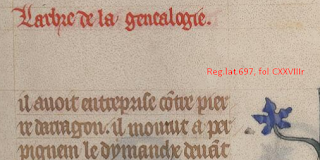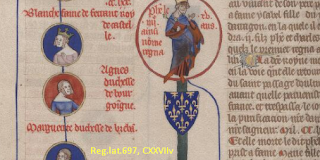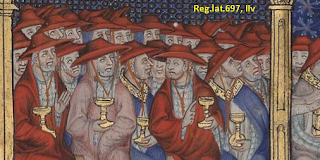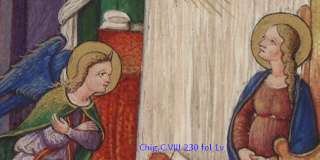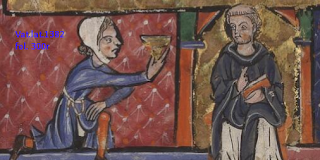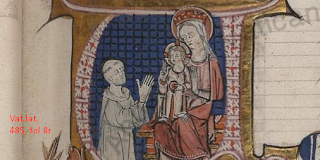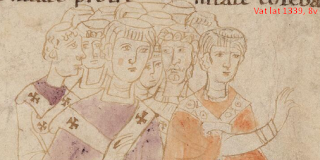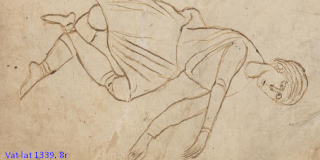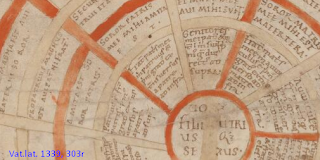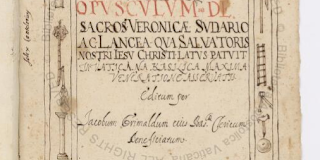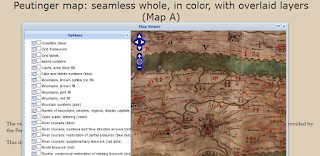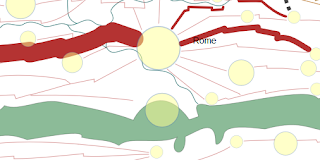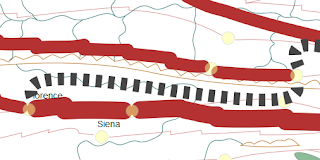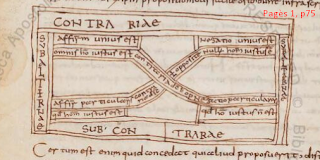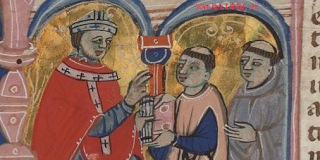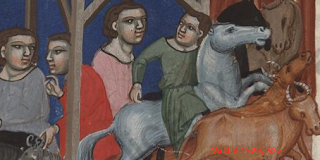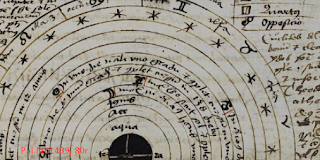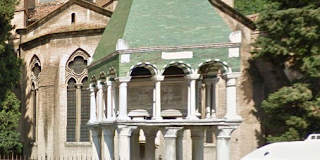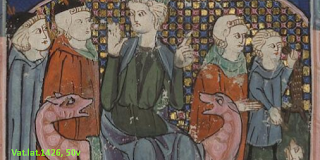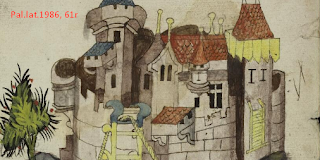One of the most interesting way-stations in that process is the invention of the term "family tree," where "tree" in its medieval sense simply meant a diagram that could be scaled up at will (just as a tree or a crystal grows) without specifically denoting that the diagram must visually resemble a natural tree.
Christine Klapisch-Zuber in her major work, L'Ombre des Ancêtres, fixes the first fusion of "genealogical" and "tree" in Latin in 1312 by Bernard Gui, a Dominican inquisitor and bishop in the south of France, who wrote a history of the French kings.That means that in the latest wave of Vatican digitizations, special interest attaches to a 1369 translation of this work into French by Jean Golein.
This forms the second part of the codex Reg.lat.697, which can now be consulted online. La Généalogie des Roys de France commences at folio CXIIr. Note the flowers and tendrils which indicate that the idea of arbre is already playing on the minds of the artists. As one sees in the example below, the main line of kings is at centre-page, descending page by page through the book, and little roundel-link stemmata of each king's non-monarchical relatives are set off to one side.
This is not Golein's autograph of course. That, according to Delisle, is in the parliamentary library in Paris. The first part of the Vatican codex contains Golein's French rendering of the Flores chronicorum, also by Bernard Gui, which is a history since the time of Jesus of the popes and Roman emperors. Reg.lat.697 is wonderfully illuminated and offers us this notable conclave of cardinals:
The full list of digitizations this week (lacking 25 extra items that slipped online on Friday morning as I was finishing) follows:
- Borg.copt.67,
- Borg.sir.16,
- Chig.C.VIII.230, with fine initials and miniatures including this Annunciation (though I could have sworn this angel has a horn!)
- Ott.lat.1302,
- Reg.lat.652,
- Reg.lat.653,
- Reg.lat.654,
- Reg.lat.659,
- Reg.lat.660,
- Reg.lat.664,
- Reg.lat.676,
- Reg.lat.678,
- Reg.lat.691,
- Reg.lat.697, translation into French by Jean Golein of the Flores chronicorum of Bernard Gui (above)
- Reg.lat.707,
- Reg.lat.709,
- Reg.lat.725,
- Reg.lat.731,
- Reg.lat.735,
- Reg.lat.737,
- Reg.lat.740,
- Reg.lat.746,
- Reg.lat.759,
- Reg.lat.761,
- Reg.lat.766,
- Reg.lat.770,
- Reg.lat.803,
- Reg.lat.864,
- Reg.lat.880,
- Reg.lat.882,
- Reg.lat.888,
- Reg.lat.891,
- Reg.lat.913,
- Reg.lat.935, Reuilion
- Sbath.251,
- Urb.lat.843.pt.1,
- Urb.lat.843.pt.2,
- Vat.gr.1312.pt.1,
- Vat.gr.1312.pt.2,
- Vat.lat.1299, Expositio in Iohannem, anon.
- Vat.lat.1302,
- Vat.lat.1310,
- Vat.lat.1317,
- Vat.lat.1325,
- Vat.lat.1382, Bottoni, Glossa Ordinaria, with some fine arbor juris diagrams, one of which has this interesting detail in the bottom panel:
- Vat.lat.1384,
- Vat.lat.1389,
- Vat.lat.1430,
- Vat.lat.1436,
- Vat.lat.1445,
- Vat.lat.1451,
- Vat.lat.1453,
- Vat.lat.1455,
- Vat.lat.1481, Priscian
- Vat.lat.1483, Priscian
- Vat.lat.1543, Macrobius
- Vat.lat.1547, Macrobius, commentary on Dream of Scipio
- Vat.lat.1567, Homer, Iliad, in Lorenzo Valla translation to Latin
- Vat.lat.1587, Horace, works, 12th century
- Vat.lat.1591, Horace, poetry
- Vat.lat.1599, Ovid
- Vat.lat.1604, Ovid, Fasti, 12th century
- Vat.lat.1605, Ovid, 15C
- Vat.lat.1618, Statius, Achilleidis
- Vat.lat.1623, Lucan, Civil Wars
- Vat.lat.1642, Seneca, tragedies
- Vat.lat.1643, Seneca, tragedies
- Vat.lat.1654,
- Vat.lat.1681, Boninius Mombrizio
- Vat.lat.1687, Cicero, letters
- Vat.lat.1690, Cicero, letters, dated 1462
- Vat.lat.1692, Cicero, letters, 15C
- Vat.lat.1693, Cicero, rhetorical works
- Vat.lat.1702, Cicero, rhetorical works
- Vat.lat.1712, Cicero, rhetorical works
- Vat.lat.1714, Ad Herennium
- Vat.lat.1718, Ad Herennium
- Vat.lat.1724, Cicero, De finibus bonorum et malorum
- Vat.lat.1726, Cicero, De finibus bonorum et malorum
- Vat.lat.1727, Cicero, De finibus bonorum et malorum
- Vat.lat.1728, Cicero, Tusculan Disputations
- Vat.lat.1733, Cicero, Tusculan Disputations
- Vat.lat.1734, Cicero, De Officiis
- Vat.lat.1739, Cicero, philosophy
- Vat.lat.1740, Cicero, philosophy
- Vat.lat.1741, Cicero, Scipio's Dream, plus anonymous works bound in back
- Vat.lat.1744, Cicero, speeches
- Vat.lat.1745, Cicero, speeches
- Vat.lat.1748, Cicero, speeches
- Vat.lat.1751, Cicero, speeches, dated 1452
- Vat.lat.1753, Cicero, speeches
- Vat.lat.1755, Cicero, speeches
- Vat.lat.1756, Cicero, speeches
- Vat.lat.1758, Cicero, philosophical works, 15C
- Vat.lat.1759, Cicero, philosophical works, 15C
- Vat.lat.1760, Cicero On Laws, Plutarch Lives in Brutus translation
- Vat.lat.1761, Quintilian
- Vat.lat.1763, Quintilian
- Vat.lat.1764, Quintilian
- Vat.lat.1765, Quintilian
- Vat.lat.1768, Quintilian
- Vat.lat.1771, Quintilian speeches, dated 1459
- Vat.lat.1774, Quintilian speeches, dated 1455
- Vat.lat.1776, Latin panegyrics
- Vat.lat.1777, Pliny the Younger, Letters, 15C
- Vat.lat.1779, Josephus in Rufinus Latin translation
- Vat.lat.1782, Phalaridis et Bruti epistulae
- Vat.lat.1784, Poggio Braccolini: De varietate fortunae (On the Vicissitudes of Fortune, 1447)
- Vat.lat.1786, Aeneas Silvius Piccolomini (Pius II), many key writings
- Vat.lat.1789, Epistulae 1-119 of Marsilio Ficino, as later published - Rome Reborn
- Vat.lat.1799, Thucydides, Peloponnesian Wars, Lorenz Valla's Latin translation; dated 1452
- Vat.lat.1800, ditto
- Vat.lat.1810, Polybius, 15C
- Vat.lat.1826,
- Vat.lat.1829, Aulus Hirtius, Caesar's Commentaries on the Gallic War, 15C
- Vat.lat.6719,
- Vat.lat.13619,
- Vat.lat.14749,
This is Piggin's Unofficial List number 119. If you have corrections or additions, please use the comments box below. Follow me on Twitter (@JBPiggin) for news of more additions to DigiVatLib.
Delisle, L. "Notice sur les manuscrits de Bernard Gui," in Notices et extraits des manuscrits de la Bibliothèque nationale et autres bibliothèques, XXVII, 2 (1879), 169-455. https://archive.org/
Klapisch-Zuber, Christiane. L’ombre des ancêtres. Paris: Fayard, 2000.
